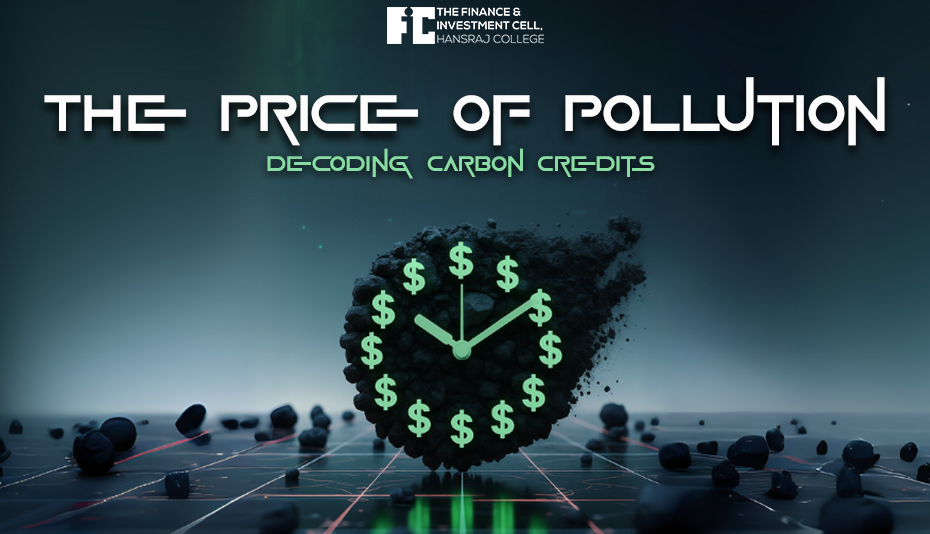Carbon Trading
- FIC Hansraj

- Nov 18, 2021
- 3 min read
Updated: Jan 10, 2022
This article is an excerpt from the July 2021 edition of the Finance Gazette Volume III. Click to read the whole edition
“We can’t save the world by playing by the rules, because the rules have to be changed”.
These wise words by Greta Thunberg resonate within each of us as we witness climate change turn into reality. What was only a textbook concept has come to life as we hear gut-wrenching tales of nature avenging itself on mankind through deadly disasters.

The Industrial Revolution was one of the early steps where we started to automate our processes in business. New machines and power sources made the whole industry more efficient than it ever was. But what seemed to be a bunch of roses had some thorns that came back to hurt us. The greenhouse gases emitted by the factories trap more heat in the Earth’s atmosphere, thus raising global temperatures and destabilizing the market. Several agreements and conventions between countries have taken place in this era with one of the most notable ones being the UN’s Kyoto Protocol of 1997 which lays the foundation of our topic today. The Kyoto Protocol enlists international mechanisms which allow countries to meet their targets of reduced Greenhouse Gases (GHGs) emissions. The highlight of this being the Carbon Trading Mechanism.
To understand this, let’s grasp what trading revolves around. Let’s take an example of a home-based business where a woman bakes cakes. She’s skilled at this and can fulfill the orders from the customers in return for a good amount. Now Carbon Trading replaces cakes with carbon credits with a few more add-ons. Each country, industry, or sector of the economy is awarded a certain number of permits to produce GHGs especially carbon dioxide to a certain level. Thus, the entities are given an allowance of the number of metric tons of CO2 they can emit. The ones who cut down their emissions can sell the surplus they possess on account of the allotment made to them to other businesses. This pushes everyone to cut down their emissions in a desire to earn from selling the emission reduction units. This is also called a cap-and-trade system.
These emission units are called ‘carbon credits’ which are freely traded between the participants. If an entity has reached its ceiling of CO2 emission allowance and plans to emit more, it can buy additional allowances and if it has been successful in limiting emissions, it can sell those extra allowances which would have otherwise served no purpose. Under the Kyoto Protocol, the developing countries did not have targets to reduce their greenhouse gases emissions, unlike the developed countries. So if a developing country or any tribal region for that matter reduces its emissions by setting up solar panels or practicing afforestation, it can sell a “credit” to a developed country that can add this credit to its existing allowance.
A big development in the carbon market took place in July 2021 as China, which is the world’s largest emitter of greenhouse gases, has launched its first national emissions-trading program. This will initially involve 2,225 companies in the power sector and will be the largest carbon market in the world. Such a setup already exists in 45 countries but none of this magnitude. This scheme has been in China’s books for a long time and is finally here after several delays to boost its effort in achieving the goal of carbon neutrality by 2060.
We must be practical and gauge if carbon trading is the blessing it promises to be. It is said to be a distraction from the bigger goal of tackling global warming by transitioning off fossil fuels. It is considered only to be a half-measure as the efforts put in by one entity to reduce emissions are eventually being bought by another party to increase emissions. Moreover, the pricing may become quite complex in a market where carbon dioxide has no intrinsic value. The credits may often be given away for free thus crashing the price. Also, the entities may falsely report the carbon credits generated. The traditional system of carbon taxes and direct regulations still holds more relevance until major reforms are done.
It does indeed give a financial incentive for countries to cut down their emissions and channelize the investment in green projects to generate more carbon credits in the long run. However, things are in tatters now as different regions have their own systems in place. So, there is a need to bring together all the regional cap and trade schemes under a global umbrella with a strong carbon price so that it proves to be a win-win situation for nature and the businesses concerned with saving it.
Author: Mayank Kedia
Illustration by: Khatwang Gupta







Comments